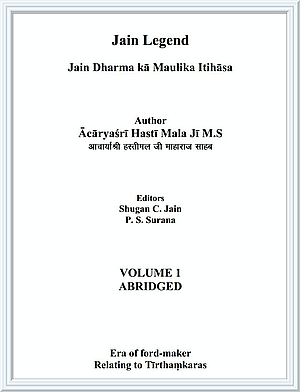The 15thTīrthaṃkara of Jain religion was Lord Śrī Dharmanātha. In his past life he was Siṃharatha, the king of Bhaddilapura, located in east Videha in Dhātakīkhaṇḍa. He was valorous and ruled over a vast empire. He was very interested in religion, considering insipid all worldly pleasures and renouncing them, became a Jain mendicant taking initiation from the monk Vimalavāhana and observing all austerities obtained the Tīrthaṃkara nāmakarma. After spending a contemplative existence with equanimity and endurance for a long time he became a powerful god in the Vaijayanta vimāna (celestial transport vehicle). Completing his term there Siṃharatha's soul entered the womb of Suvratā, the queen of the valiant king Bhānu of Ratnapura on the 7th day of the bright half of the Vaiśākha month under constellation Puṣya. Queen Suvratā was delighted to see the 14 great dreams. Upon completion of her pregnancy she gave birth to a son on the third day of the bright fortnight of Māgha under constellation Puṣya. The birth was celebrated with gaiety. When the child was in her womb the mother used to get a pregnancy whim of religious merit, thinking thus the son was named Dharmanātha.
When he became a young man, to fulfil his father's desires, Dharmanātha married and then for 2 lakh 50 thousand years ruled the kingdom. After managing the affairs of the kingdom for 5 lakh years he became inclined towards initiation. On request by the lokāntikagods Dharmanātha gave charities for a year and observing fast with 1000 kings, on the 13th day of the bright fortnight of Māgha under Puṣya constellation, renouncing all bad karmas, he became an initiate/monk. The next day he broke his fast at the home of the king of Somanasa city, Dharmasimṃha, by taking rice pudding.
After becoming a monk, bearing with many difficulties and trials Lord Dharmanātha roamed about as mendicant for 2 years. Thereafter, reaching the place of initiation, moving from deep meditation to kṣapakaśreṇi under the Dadhiparṇa tree, destroying obscuring karmas, he attained pure intuition and knowledge on the full moon of Pauṣa month under Puṣya constellation. After becoming omniscient, in a grand assembly of gods and men he said in his sermon "you fight with your own internal flaws /impurities, understand your own self and its nature, and by giving up worldly pleasures, enjoy a state of bliss." Hearing his sermon thousands accepted the path of right conduct. Establishing the four-fold creed the Lord became Tīrthaṃkara of the time.
The congregation of Lord Dharmanātha included 43 Gaṇadharas including Ariṣṭā, etc. 4500 omniscient, 4500 telepaths, 3600 clairvoyants, 900 14-pūrvadhārīs, 7000 vaikriyalabdhidhārīs, 2800 vādīs, 64000 monks, 62400 female-monks, 244000 votaries and 413000 female-votaries.
Two years less than two-and-a-half lakh years Lord Dharmanātha wandered as an Omniscient uplifting lakhs of people. Sensing the time of his salvation, he observed a fast unto death for one month at Sammetaśikhara with 800 monks and on the fifth day of the bright fortnight of Jyeṣṭha under constellation Puṣya, stopping all activities and destroying all karmas, attained liberation and nirvāṇa at the age of 10 lakh years.
The Bright Gems of Lord Dharmanātha's Period
On hearing the greatness of Lord Dharmanātha, Vasudeva Puruṣasiṃha and Baladeva Sudarśana became initiates into the true religion. Puruṣasiṃha became Vasudeva of three regions (khaṇḍa) by killing Prati Vasudeva Niśumbha, and because of his major ill deeds went to the sixth hell. Grieving over his brother, Sudarśana took the vow and observing right austerities, attained liberation.
In the period of Lord Dharmanātha, after his nirvāṇa there were two world-emperors (cakravartīs) - the third cakravartī Maghavā and the fourth Sanatkumāra. A brief introduction to these two cakravartīs follows.
 Acharya Hasti Mala
Acharya Hasti Mala
